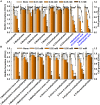Suppression of Fluconazole Resistant Candida albicans Biofilm Formation and Filamentation by Methylindole Derivatives
- PMID: 30459738
- PMCID: PMC6232606
- DOI: 10.3389/fmicb.2018.02641
Suppression of Fluconazole Resistant Candida albicans Biofilm Formation and Filamentation by Methylindole Derivatives
Abstract
Candida albicans is an opportunistic fungal pathogen and most prevalent species among clinical outbreaks. It causes a range of infections, including from mild mucosal infections to serious life-threatening candidemia and disseminated candidiasis. Multiple virulence factors account for the pathogenic nature of C. albicans, and its morphological transition from budding yeast to hyphal form and subsequent biofilm formation is regarded as the most important reason for the severity of Candida infections. To address the demanding need for novel antifungals, we investigated the anti-biofilm activities of various methylindoles against C. albicans using a crystal violet assay, and the metabolic activity was assessed by using a 2,3-bis (2-methoxy-4-nitro-5-sulfo-phenyl)-2H-tetrazolium-5-carboxanilide reduction assay. Changes in biofilm morphologies and thicknesses were determined by confocal laser scanning microscopy and scanning electron microscopy, respectively. Of the 21 methylindoles tested, 1-methylindole-2-carboxylic acid (1MI2CA) at 0.1 mM (17.5 μg ml-1) and 5-methylindole-2-carboxylic acid (5MI2CA) at 0.1 mM effectively inhibited biofilm formation by C. albicans DAY185 and ATCC10231 strains. Moreover, 1MI2CA and 5MI2CA both effectively inhibited hyphal formation, and thus, improved C. albicans infected nematode survival without inducing acute toxic effects. Furthermore, our in silico molecular modeling findings were in-line with in vitro observations. This study provides information useful for the development of novel strategies targeting candidiasis and biofilm-related infections.
Keywords: C. albicans; C. elegans; biofilm; filamentation; methylindoles.
Figures






Similar articles
-
Alizarin and Chrysazin Inhibit Biofilm and Hyphal Formation by Candida albicans.Front Cell Infect Microbiol. 2017 Oct 16;7:447. doi: 10.3389/fcimb.2017.00447. eCollection 2017. Front Cell Infect Microbiol. 2017. PMID: 29085811 Free PMC article.
-
Effects of magnolol and honokiol on adhesion, yeast-hyphal transition, and formation of biofilm by Candida albicans.PLoS One. 2015 Feb 24;10(2):e0117695. doi: 10.1371/journal.pone.0117695. eCollection 2015. PLoS One. 2015. PMID: 25710475 Free PMC article.
-
Characteristics of biofilm formation by Candida albicans.Rev Iberoam Micol. 2001 Dec;18(4):163-70. Rev Iberoam Micol. 2001. PMID: 15496122
-
Pathogenic factors in Candida biofilm-related infectious diseases.J Appl Microbiol. 2017 Feb;122(2):321-330. doi: 10.1111/jam.13330. Epub 2016 Nov 24. J Appl Microbiol. 2017. PMID: 27770500 Review.
-
Candida and candidaemia. Susceptibility and epidemiology.Dan Med J. 2013 Nov;60(11):B4698. Dan Med J. 2013. PMID: 24192246 Review.
Cited by
-
Pulmonary Candidiasis Associated with COVID-19: Evaluation of Causative Agents and their Antifungal Susceptibility Patterns.Tanaffos. 2021 Jan;20(1):29-35. Tanaffos. 2021. PMID: 34394367 Free PMC article.
-
The Anticancer Agent 3,3'-Diindolylmethane Inhibits Multispecies Biofilm Formation by Acne-Causing Bacteria and Candida albicans.Microbiol Spectr. 2022 Feb 23;10(1):e0205621. doi: 10.1128/spectrum.02056-21. Epub 2022 Feb 2. Microbiol Spectr. 2022. PMID: 35107361 Free PMC article.
-
Evaluation of Anti-Biofilm Capability of Cordycepin Against Candida albicans.Infect Drug Resist. 2021 Feb 5;14:435-448. doi: 10.2147/IDR.S285690. eCollection 2021. Infect Drug Resist. 2021. PMID: 33574683 Free PMC article.
-
Advances in Fungal Peptide Vaccines.J Fungi (Basel). 2020 Jul 25;6(3):119. doi: 10.3390/jof6030119. J Fungi (Basel). 2020. PMID: 32722452 Free PMC article. Review.
-
Chemical Profile, Anti-Microbial and Anti-Inflammaging Activities of Santolina rosmarinifolia L. Essential Oil from Portugal.Antibiotics (Basel). 2023 Jan 15;12(1):179. doi: 10.3390/antibiotics12010179. Antibiotics (Basel). 2023. PMID: 36671380 Free PMC article.
References
-
- CDC (2013). Centers for Disease Control and Prevention. Antibiotic Resistance Threats in the United States. Available at: https://www.cdc.gov/drugresistance/biggest_threats.html
-
- Desai N. C., Patel B. Y., Dave B. P. (2017). Synthesis and antimicrobial activity of novel quinoline derivatives bearing pyrazoline and pyridine analogues. Med. Chem. Res. 26 109–119. 10.1007/s00044-016-1732-6 - DOI
LinkOut - more resources
Full Text Sources
Miscellaneous

